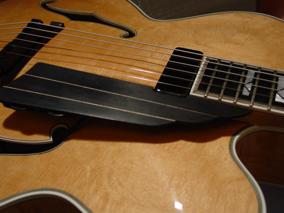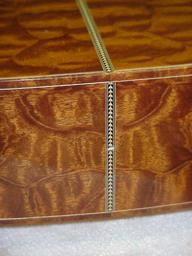
![]()
Wells Guitar Co.
(781) 361-1471
![]()
|
|
Why Should You Purchase a Wells/Bay State Custom Made Instrument?
To be perfectly frank, the major guitar factories make terrific instruments at what used to be a very reasonable cost. However, because those instruments are factory produced, their quality, innovation and selection is limited. There also are hundreds of the exact same instrument out there. Nothing is being produced specifically for you.
As I view the guitar producers, musicians have a golden opportunity to tailor the perfect instrument for themselves. If that instrument is one of the mass produced models made by one of the guitar factories, then that is what you should play. But, if you value the quality of your playing and, especially the tone the instrument with your hands in control, then I would respectfully suggest that you look carefully at some of the custom builders. The good part of that suggestion is that there are more builders than ever for you to choose from. And most create a quality instrument. But what I really want you to do is to carefully look at what differentiates a Wells guitar from all the others. So what makes a Wells (and Bay State) guitar different from the pack? There are several answers to that question. I will attempt to cover the bases. 1)
Every piece of wood and every design decision of a Wells guitar is done by me, Sylvan Wells. An acoustic guitar's top, coupled with its' bracing, determines its' unique sound. As a result, I personally thickness and voice the solid spruce top of every guitar I make. My guitars have a very rich and unique sound. I believe that is because each top is voiced by me for its’ optimum response. After voicing the top much time and effort is devoted to finding the perfect, sonically matched, back and side combination for that individual top. I use my thirty five years of guitar building experience to find the perfect match of materials so the finished product can be as good as it can be;
2)
Every step of the building process has been thought, re-thought and refined over the past thirty five years. Ask your guitarmaker why he/she does something the way they do. They ought to be able to give you an answer that makes sense. There are specific reasons for every building step and your builder should be able to explain it. I can explain, in detail, each and every step in the construction of a Wells guitar. As a result, much of the building process in building a Wells guitar is different and distinct from the way other builders build and the guitars reflect that dedication;
3)
All Wells instruments delivered after January 1, 2009, including the new Bay State models, incorporate the new and proprietary Tone Enhancer™ technology. The Tone Enhancer™ technology provides an integrated series of innovations which substantially inproves the tonal color of the instrument. A by-product of the technology demonstrates an immediate responsiveness in the instruments' attack and decay rate, providing the player with a whole new level of tonal playability;
4)
In addition to using the very best of materials and the Tone Enhancer™ technology, a Wells guitar has other “state of the art” design features largely not found on other guitars, even those made by other custom builders. Some of those features are:
a. Semi-hemispherical frets. Semi-hemispherical frets are simply frets that are finished in a semi-hemispherical way as opposed to a angled bevel on each side of the fingerboard. Semi-hemispherical frets' benefits include b. Partially domed top. Many builders’ and factories dome (put a defined curve in their tops) the tops of their instruments. Doming increases the strength of the top but creates other structural problems such as where the fretboard joins the body. Wells (and Bay State) guitars are constructed differently, i.e., a Wells guitar top is domed where it needs it most (behind the soundhole and through the bridge area) and perfectly flat where the neck joins the body. This allows the fretboard to make good solid contact with the top and allows the neck to vibrate freely contributing to the sound of the instrument. If anyone tells you the neck doesn’t contribute to the sound try a simple demonstration. Borrow a woodworking clamp and clamp it to the headstock. Notice the guitar gets louder? Enough said. c. Glues Used. All factories and a great amount of custom builders use aliphatic resin (yellow) glues for the construction of their instruments. That is not the way it was done in the "golden age" of instrument making (Pre-World War II). Those guitar makers appreciated the vast advantages of animal or hide glues which have been in use by woodworkers for 3,000 years. Although difficult to prepare and apply, these glues contributed greatly to the wonderful sound of those older instruments. The longevity of the glue joint is a proven fact. Some aliphatic yellow glues dry almost rubbery; animal glues dry crystaline. As a result those adhesives do not dampen the sound of the instrument in the least. A Wells guitar is constructed with both animal glues and special luthier glues that dry to a crystaline state, preserving the natural sound of the instrument. No rubbery glues are used at all in the construction of a Wells/Bay State instrument. This makes a huge difference in the quality and tonality of the construction. d. Playability. I take great pride in making instruments play in an extraordinary way. Any new instrument made of wooden pieces need to "learn" how to become a guitar. When the instrument is first built it is just a collection of parts that now must learn to work together to make extraordinary music. This is why musicians always talk about having to "break-in" a new guitar. That usually takes months of playing. Wells Guitars is pleased to announce that all of the Wells (and Bay State) instruments shipped after February 1, 2010 have been subjected to the Tonerite® 72 hour de-damping (play-in) process. The secret behind the Tonerite® device is its ability to continually produce and efficiently transfer vibrational energy into an instrument, safely recreating and magnifying the physics that occur naturally while playing. This stimulation produces a change to the integrated components within an instrument and increases their ability to resonate together as a whole. The result is added volume and instruments that are easier to play with a sound that is more full and balanced. Not only will your instrument sound better but the notes themselves will come easier, allowing you to play more difficult passages with less fatigue. The Tonerite® process effectively duplicates months of "breaking-in a new instrument in its' 72 hour process. After all, a custom guitar should just sound and play better than any factory instrument from the first strum to its' last. The Tonerite® treatment makes the guitar sound great right away. After the Tonerite® treatment, I personally play the guitar for at least thirty minutes to insure that the playability is up to my exacting standards. The biggest compliment I get with my instruments is that they are so, so easy to play. Players' naturally gravitate to, and play guitars which are easy to play and make them sound so good. I take many steps and spend countless hours on playability. If you don't like the way an instrument plays, you just won't play it - it does not matter at that point how pretty it is! I challenge any guitarmaker to produce a guitar with the playability of a Wells instrument The sound and playability of an instrument is an accumulation of hundreds of design decisions and the luthiers ability to fully execute them properly. There are no magic answers BUT it is all dependent on the luthiers experience and talent. I have been building instruments for over 37 years and each and every part of the guitar has been thought and re-thought, designed and re-designed to make the instrument the best it can be. Experience the difference yourself. A custom made guitar - a Wells or Bay State guitar - will bring you so much closer to that goal you wanted to really play and sound better and better!
|


